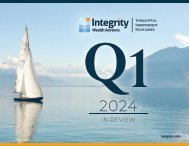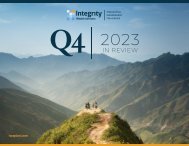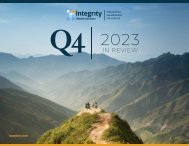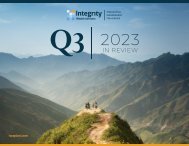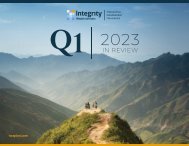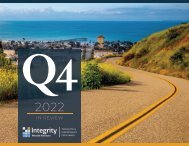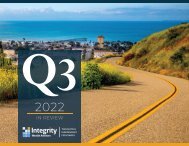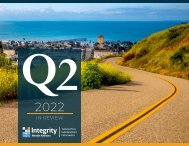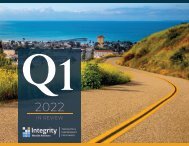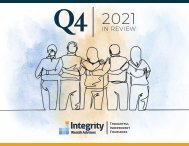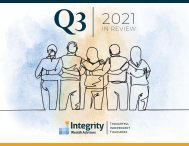2023 Q2 In Review - Integrity Wealth Advisors, Ventura & Ojai, California
- No tags were found...
Create successful ePaper yourself
Turn your PDF publications into a flip-book with our unique Google optimized e-Paper software.
iwaplan.com<br />
<strong>Q2</strong> <strong>2023</strong><br />
IN REVIEW
TOTAL RETURN <strong>2023</strong> <strong>Q2</strong> + NEWSWORTHY EVENTS<br />
April 2 – OPEC+ announced<br />
that they were cutting daily<br />
petroleum output by 1.16<br />
million barrels per day<br />
April 20 – SpaceX's Starship<br />
rocket, the largest and most<br />
powerful rocket ever built,<br />
is launched during a flight<br />
test from a base in Boca<br />
Chica, Texas, exploding four<br />
minutes after launch<br />
May 1 – San Francisco-based First Republic<br />
Bank fails and is auctioned off by the US<br />
FDIC to JPMorgan Chase for $10.7 billion<br />
May 6 – The coronation of<br />
Charles III and Camilla as King<br />
and Queen of the United Kingdom<br />
and the other Commonwealth<br />
realms is held in Westminster<br />
Abbey, London<br />
June 2 – Congress approves<br />
deal raising debt ceiling,<br />
averting U.S. default<br />
June 14 – The Federal<br />
Reserve took a pause<br />
on hiking rates for the<br />
first time in more than<br />
a year, as inflation<br />
continues to slow and<br />
the economy shows<br />
signs of easing<br />
June 18 – All five<br />
crew members<br />
of Titan, a deepsea<br />
submersible<br />
exploring the wreck<br />
of the Titanic, are<br />
killed following<br />
a catastrophic<br />
implosion of the<br />
vessel<br />
June 23 – The Wagner Group begins<br />
an armed conflict with the Russian<br />
military, seizing the city of Rostovon-Don<br />
and portions of the Voronezh<br />
Oblast before withdrawing the<br />
next day, after a peace agreement<br />
brokered by Belarusian President<br />
Alexander Lukashenko<br />
9%<br />
S&P 500 TOTAL RETURN<br />
MSCI ACWI EX USA TOTAL RETURN<br />
BARCLAYS US AGGREGATE TOTAL RETURN<br />
8.74%<br />
8%<br />
7%<br />
6%<br />
5%<br />
4%<br />
3%<br />
2.67%<br />
2%<br />
1%<br />
0%<br />
-1%<br />
-1.25%<br />
-2%<br />
April<br />
May<br />
June<br />
As of close 6/30/<strong>2023</strong><br />
12%<br />
S&P 500 TOTAL RETURN<br />
MSCI ACWI EX USA TOTAL RETURN<br />
BARCLAYS US AGGREGATE TOTAL RETURN<br />
Source: https://en.wikipedia.org/wiki/<strong>2023</strong><br />
11%<br />
10.42%
THE NEW REALITY FOR INVESTORS<br />
<strong>2023</strong><br />
<strong>Q2</strong><br />
IN REVIEW<br />
As we approach the midway point of <strong>2023</strong>, it is evident that we are facing<br />
significant uncertainty and a landscape of change. We find ourselves amidst a<br />
period of transition in the global economy, financial markets, and various sectors.<br />
The market, once characterized by a binary nature, has now become more<br />
balanced.<br />
<strong>In</strong> the past, investors could concentrate solely on a select few internet-related<br />
behemoths, disregarding everything else. They could borrow money at near-zero<br />
interest rates without concern for the consequences of such easy access to<br />
capital, the looming threat of inflation, or the potential for central banks to raise<br />
interest rates. However, times have changed, and this shift brings positive news<br />
for investors. The market no longer moves exclusively in a single direction, which<br />
creates a more compelling and diverse environment. The range of opportunities<br />
has expanded to encompass both American and international companies, growth<br />
stocks and value stocks, the technology sector and healthcare, industrials and<br />
energy, short-term and long-term bonds, as well as treasuries and corporate bonds.<br />
We now reside in a world where diligent investors can identify both cyclical and<br />
secular opportunities, but this necessitates conducting thorough research.<br />
It’s important to note, we are also searching for opportunities where the baby has<br />
been thrown out with the bathwater — that is, companies left humbled by the selloff<br />
of 2022, but still worth our attention because business models remain intact,<br />
earnings are holding up and the potential for stock price appreciation remains<br />
strong. Throughout this year, we have witnessed impressive comebacks from<br />
technology and consumer sector companies.<br />
It is essential to recognize that risks have also grown. These risks encompass not<br />
only market and economic factors but also policy-related concerns. Questions<br />
arise regarding the relationship between the United States and China, the potential<br />
escalation of the conflict in Ukraine, and the regulatory response to the banking<br />
sector's crisis of confidence. All these factors must be carefully considered when<br />
evaluating potential investments. Furthermore, as investors, we must be prepared<br />
to endure short-term discomfort for long-term benefits.<br />
Undeniably, the present moment presents a great opportunity for active investors.<br />
It has become increasingly crucial to search for investment prospects on a global<br />
scale while remaining vigilant regarding growing risks in the market, economy,<br />
and the world at large. Given the prevailing uncertainty, a considerable amount of<br />
cash is currently sitting on the sidelines. This may indeed be an opportune time to<br />
contemplate deploying those funds into the market.<br />
ECONOMIC CHARTS & NOTES<br />
CONSUMER SENTIMENT Consumer sentiment is up 28% from last year's<br />
historic low, which could bode well for spending in the months ahead. Retail sales<br />
have picked up the last couple months but continue to be hampered by inflation.<br />
EMPLOYMENT The U.S. unemployment rate has ticked up to 3.7% but<br />
remains historically low. Nonfarm payrolls increased much more than expected<br />
in May led by strong job creation in professional and business services.<br />
US Retail Sales<br />
Consumer Sentiment<br />
Unemployment Rate<br />
NonFarm Payroll<br />
34%<br />
100<br />
16%<br />
2200<br />
US Retail Sales % Chg<br />
28%<br />
22%<br />
16%<br />
10%<br />
4%<br />
-2%<br />
-8%<br />
90<br />
80<br />
70<br />
60<br />
Consumer Sentiment<br />
Unemployment Rate %<br />
14%<br />
12%<br />
10%<br />
8%<br />
6%<br />
4%<br />
-825<br />
-3850<br />
-6875<br />
-9900<br />
-12925<br />
-15950<br />
-18975<br />
NonFarm Payroll<br />
-14%<br />
Jan '19<br />
Jul '19<br />
Jan '20<br />
Jul '20<br />
Jan '21<br />
Jul '21<br />
Jan '22<br />
Jul '22<br />
Jan '23<br />
50<br />
2%<br />
Jan ' 19<br />
Jul '19<br />
Jan '20<br />
Jul '20<br />
Jan '21<br />
Jul '21<br />
Jan '22<br />
Jul '22<br />
Jan '23<br />
-22000<br />
Source: University of Michigan Consumer Sentiment. Retail Sales - U.S. Census Bureau.<br />
Source: U.S. Bureau of Labor Statistics
ECONOMIC CHARTS & NOTES<br />
CONSUMER PRICE INDEX The pace of consumer price increases has<br />
cooled, but shelter and used vehicle prices continue to rise significantly. Falling<br />
energy prices are the main driver of cooling inflation.<br />
CONSUMER SPENDING Real disposable income has increased five straight<br />
months amid wage gains and moderating inflation. The key Fed inflation figure<br />
(PCE) rose slightly last month as Americans spent more on services than highpriced<br />
goods.<br />
Y/Y % Chg<br />
8%<br />
7%<br />
6%<br />
5%<br />
4%<br />
3%<br />
2%<br />
1%<br />
0%<br />
CPI Less Food<br />
CPI All<br />
2018 2019 2020 2021<br />
2022<br />
% Chg Year-over-year<br />
30<br />
25<br />
20<br />
15<br />
10<br />
5<br />
0<br />
-5<br />
-10<br />
-15<br />
-20<br />
-25<br />
Jan '19<br />
Jul '19<br />
Consumption<br />
Jan '20 Jul ' 20 Jan '21<br />
Jul '21<br />
Disposable <strong>In</strong>come<br />
Jan '22 Jul '22 Jan '23<br />
Source: U.S. Bureau of Labor Statistics<br />
Source: U.S. Bureau of Economic Analysis<br />
JOB OPENINGS & HIRES Retail hiring is down from last year with inflation<br />
and credit card rates impacting shopper behavior. Finding qualified candidates<br />
has also been a challenge for the retail, construction, manufacturing, and<br />
transportation sectors.<br />
Retail Openings<br />
Retail Hires<br />
GDP First quarter GDP was revised sharply higher due to upward adjustments in<br />
consumer spending and inventories. A 8.7% boost in Social Security cost of living<br />
likely had a big impact on spending.<br />
GDP<br />
Amount in Thousands<br />
1500<br />
1200<br />
900<br />
600<br />
300<br />
0<br />
Jan '18 Jul '18 Jan '19 Jul '19 Jan '20 Jul '20 Jan '21 Jul '21 Jan '22 Jul '22 Jan '23<br />
% Growth<br />
40%<br />
35%<br />
30%<br />
25%<br />
20%<br />
15%<br />
10%<br />
5%<br />
0%<br />
-5%<br />
-10%<br />
-15%<br />
-20%<br />
-25%<br />
-30%<br />
Q1 <strong>Q2</strong> Q3 Q4 Q1 <strong>Q2</strong> Q3 Q4 Q1 <strong>Q2</strong> Q3 Q4 Q1 <strong>Q2</strong> Q3 Q1 Q4 <strong>Q2</strong> Q3 Q4 Q1<br />
2018<br />
2019 2020 2021 2022 <strong>2023</strong><br />
Source: U.S. Bureau of Labor Statistics<br />
Source: U.S. Bureau of Economic Analysis
<strong>In</strong>flation has eased as rate-hiking<br />
cycle nears an end<br />
INFLATION HAS EASED AS RATE-HIKING<br />
CYCLE NEARS AN END<br />
<strong>2023</strong><br />
<strong>Q2</strong><br />
IN REVIEW<br />
<strong>In</strong>flation, still elevated, is less fierce<br />
Annual consumer price index (%)<br />
12<br />
United Kingdom<br />
10<br />
Eurozone<br />
8<br />
United States<br />
6<br />
Japan<br />
4<br />
2<br />
0<br />
Estimates<br />
Jul-18 Jul-19 Jul-20 Jul-21 Jul-22 Jul-23 Jul-24<br />
Markets expect a decline in rates over the next year<br />
Federal funds rate — Actual and market implied (%)<br />
6<br />
5<br />
4<br />
3<br />
2<br />
1<br />
Fed funds<br />
target rate<br />
Market-implied<br />
effective rate as of<br />
5/31/23<br />
0<br />
Mar-22 Jun-22 Sep-22 Dec-22 Mar-23 Jun-23 Sep-23 Dec-23 Mar-24 Jun-24<br />
It may not feel like it at the grocery store, but inflation is well above the U.S. Federal Reserve’s 2% target, but “We knew there would be consequences to one of the<br />
on It may a downward not feel trajectory like it at the in the grocery U.S., Europe store, and but inflation many is<br />
monetary<br />
on a downward<br />
policy often works with<br />
The<br />
long<br />
recent<br />
lags,<br />
U.S.<br />
so<br />
banking<br />
the full<br />
turmoil<br />
most<br />
could<br />
aggressive<br />
also help<br />
tightening<br />
slow economic<br />
campaigns<br />
growth<br />
in history,”<br />
as<br />
says<br />
other<br />
trajectory<br />
markets.<br />
in the<br />
That’s<br />
U.S.,<br />
largely<br />
Europe<br />
due<br />
and<br />
to lower<br />
many<br />
energy<br />
other<br />
prices,<br />
markets. That’s<br />
impact<br />
largely<br />
of rate hikes<br />
due to<br />
should spread<br />
some<br />
through<br />
banks may<br />
the rest<br />
become<br />
of<br />
more<br />
fixed<br />
cautious<br />
income portfolio<br />
and reduce<br />
manager<br />
their<br />
Pramod<br />
lending<br />
Atluri.<br />
activities.<br />
“The<br />
fewer<br />
lower<br />
supply<br />
energy<br />
chain<br />
prices,<br />
disruptions<br />
fewer supply<br />
and a<br />
chain<br />
steady<br />
disruptions<br />
series of<br />
and<br />
the<br />
a steady<br />
economy<br />
series<br />
over<br />
of<br />
time.<br />
Taken together, these factors<br />
dislocations<br />
have significantly<br />
we are seeing<br />
changed<br />
in the financial markets signal<br />
interest rate hikes by central banks.<br />
a painful new phase for the Fed. It has clearly exposed<br />
interest rate hikes by central banks.<br />
The recent U.S. banking turmoil the could interest also rate help outlook. slow<br />
some vulnerabilities and, as a result, I believe we are<br />
<strong>In</strong>terest rate-sensitive industries such as housing are economic growth as some banks may become more<br />
nearing the end of this rate-hiking cycle.”<br />
already <strong>In</strong>terest feeling rate-sensitive the effects, industries with home such prices as falling housing are already cautious feeling and reduce the their lending Everyone activities. knew Taken there would be consequences to one of the most aggressive<br />
in effects, some formerly with home hot prices markets. falling <strong>In</strong>flation in some still remains formerly hot markets. together, <strong>In</strong>flation these factors still have significantly tightening changed cycles in history. The dislocations we are seeing in the financial<br />
remains well above the U.S. Federal Reserve’s 2% target, the but interest monetary rate outlook. policy markets signal a painful new phase for the Fed. It has clearly exposed some<br />
often works with long lags, so the full impact of rate hikes should spread vulnerabilities and, as a result, we believe we are nearing the end of this ratehiking<br />
Statistics, cycle. Japanese Statistics Bureau & Statistics Center, <strong>In</strong>ternational Monetary Fund.<br />
through the rest<br />
sources for left chart:<br />
of the Capital economy Group, FactSet, over time. Bureau of Labor Statistics, Eurostat, UK Office for National<br />
Data as of June 5, <strong>2023</strong>. Consumer price indexes for each region provide a measure of the average change over time in the prices paid for a basket of consumer goods and services. sources for<br />
right chart: Capital Group, Bloomberg <strong>In</strong>dex Services Ltd., Refinitiv Datastream, U.S. Federal Reserve. Fed funds target rate reflects the upper bound of the Federal Open Markets Committee’s<br />
(FOMC) target range for overnight lending among U.S. banks. As of May 31, <strong>2023</strong>.<br />
SOURCES FOR LEFT CHART: Capital Group, FactSet, Bureau of Labor Statistics, Eurostat, UK Office for National Statistics, Japanese Statistics Bureau & Statistics Center, <strong>In</strong>ternational Monetary Fund. Data as of<br />
June 5, <strong>2023</strong>. Consumer price indexes for each region provide a measure of the average change over time in the prices paid for a basket of consumer goods and services. SOURCES FOR RIGHT CHART: Capital Group,<br />
3 Bloomberg · MIDYEAR <strong>In</strong>dex OUTLOOK Services Ltd., <strong>2023</strong> Refinitiv Datastream, U.S. Federal Reserve. Fed funds target rate reflects the upper bound of the Federal Open Markets Committee’s (FOMC) target range for overnight lending among<br />
U.S. banks. As of May 31, <strong>2023</strong>.
A MOUNTAIN OF CASH CAN BE A BULLISH SIGNAL<br />
INVESTORS' FLIGHT TO CASH HAS SURPASSED THAT OF THE PANDEMIC AND FINANCIAL CRISIS<br />
<strong>In</strong>vestors have anointed cash as king, shifting assets out of stock and bond<br />
investments and driving money market totals to a record $5.4 trillion as of May<br />
31, <strong>2023</strong>.<br />
This flight to cash and cash alternatives (such as money market funds and shortterm<br />
treasuries) is understandable following last year’s tandem decline of stocks<br />
and bonds in the face of rising interest rates, inflation and slowing economic<br />
growth. Many investors moved deposits from banks to money markets amid<br />
ongoing volatility and relatively high yields on cash instruments.<br />
After the painful losses of 2022, more risk averse investors might consider<br />
allocating some cash to dividend-paying stocks, which provide income and<br />
capital appreciation potential, and<br />
select short- and intermediateterm<br />
bonds, which have<br />
been offering higher<br />
yields than in<br />
2022.<br />
But conditions have shifted thus far in <strong>2023</strong>, and long-term investors may want to<br />
rethink their approach. Levels of cash alternatives peaked near two recent market<br />
troughs. During the global financial crisis, for example, money market fund assets<br />
peaked two months before the S&P 500 <strong>In</strong>dex reached a bottom on March 9,<br />
2009. The stock market recorded a 40% return over the subsequent three months<br />
and a 55% return over the following six months. Similarly, during the pandemic,<br />
money market fund levels reached a high weeks after the S&P 500 reached its<br />
trough in March 2020.<br />
Source: Capital Group, Bloomberg <strong>In</strong>dex Services Ltd., <strong>In</strong>vestment Company <strong>In</strong>stitute (ICI), Standard & Poor's. As of May 31, <strong>2023</strong>. <strong>In</strong> the<br />
chart, "cash peak" refers to peak money market fund assets. Unlike cash, which may be insured or guaranteed by the Federal Deposit <strong>In</strong>surance Corporation,<br />
dividend-paying stocks, short- and intermediate-term bonds are not guaranteed and are subject to loss. Past results are not predictive of results in future periods.
INVESTORS MAY BE WISE TO PUT CASH TO WORK<br />
<strong>2023</strong><br />
<strong>Q2</strong><br />
IN REVIEW<br />
Market volatility hastened a flight to cash for many investors. While<br />
understandable, this response effectively placed investment objectives on<br />
hold and relinquished long-term return potential. <strong>In</strong>vestors were hit hard in<br />
2022 as the Federal Reserve started raising interest rates and both stocks<br />
and bonds posted losses. With inflation inching toward normal and the Fed<br />
pausing interest rate hikes, now is an opportune time for investors to consider<br />
moving back into a balanced strategy.<br />
Valuations across a range of stocks are more attractive, and bonds are now<br />
offering more income and higher return potential.<br />
Over the last four hiking cycles since 1995, investing after the last Fed rate<br />
increase has generated strong returns for both stocks and bonds. What is<br />
more, the best returns occurred in the first 12 months after the last rate hike.<br />
STOCKS AND<br />
BONDS HAVE<br />
OUTPACED CASH<br />
AFTER A FED<br />
HIKING CYCLE<br />
Source: Bloomberg <strong>In</strong>dex Services Ltd., MSCI, Refinitiv Datastream, Standard & Poor's. Returns reflect the average cumulative return over each of the first 12 months immediately following the last increase in the target<br />
U.S. federal funds rate ("last Fed hike") over the prior four hiking cycles. The specific start months for the periods included in the average calculations are: February 1995, May 2000, June 2006, and December 2018. U.S.<br />
bonds are represented by the total return of the Bloomberg U.S. Aggregate <strong>In</strong>dex; U.S. equities are represented by the total return for the S&P 500 <strong>In</strong>dex; the 60/40 portfolio is represented as the weighted average return<br />
using 60% of the total return for the S&P 500 <strong>In</strong>dex and 40% of the total return in U.S. dollars for the Bloomberg U.S. Aggregate <strong>In</strong>dex, with no rebalancing for the first 12 months. <strong>In</strong>ternational equities are represented by<br />
the total return in U.S. dollars for the MSCI EAFE <strong>In</strong>dex; U.S. short-term bonds are represented by the total return for the Bloomberg 1-3 Year U.S. Government/Credit <strong>In</strong>dex; cash is represented by change in the Bloomberg<br />
U.S. Treasury Bill 1-3 Months <strong>In</strong>dex. As of May 31, <strong>2023</strong>. Past results are not predictive of results in future periods.
INVESTMENT<br />
MANAGEMENT<br />
PHILOSOPHY<br />
The complex, ever-changing investment world of today<br />
requires an investment process that is overseen by a team<br />
of experienced investment professionals. Global capital<br />
markets present investors with a host of challenges due to<br />
the combination of an overwhelming amount of information<br />
to analyze and the endless supply of conflicting opinions and<br />
narratives surrounding financial markets. The time and expertise<br />
required to perform in-depth investment research and to make<br />
timely and informed portfolio management decisions requires<br />
both a clear investment process and an experienced investment<br />
team to implement the process.<br />
An old adage states that there is accomplishment through<br />
many advisors. We agree and embrace a variety of investment<br />
perspectives through our investment committee. Our investment<br />
philosophy is well grounded in global macro-economic analysis.<br />
<strong>In</strong>vestment ideas are carefully vetted through a process which<br />
incorporates the diverse range of investment backgrounds<br />
within our firm. This process of multifaceted analysis ensures<br />
that only the strongest investment ideas survive. We are<br />
committed to striking the right balance between risk and<br />
return through managing global, multi-asset class investment<br />
portfolios.<br />
INDEPENDENCE &<br />
CLIENT FOCUS<br />
DIVERSIFICATION<br />
TOP-DOWN, THEMATIC<br />
APPROACH<br />
PERFORMANCE WITH<br />
LIQUIDITY<br />
VARIED INVESTMENT<br />
PERSPECTIVES<br />
OPTIMIZATION OF<br />
EXPENSES AND TAXES<br />
THE INVESTMENT PROCESS<br />
ASSESSMENT OF GLOBAL<br />
ECONOMIC & INVESTMENT<br />
ENVIRONMENT<br />
ASSESS & ANALYZE<br />
THEMES<br />
RESEARCH INVESTMENT<br />
VEHICLES TO FIND<br />
EFFECTIVE IMPLEMENTATION<br />
IDENTIFY<br />
OPPORTUNITIES<br />
STRATEGIC ASSET<br />
ALLOCATION -<br />
Geographies, Sectors,<br />
Capitalizations<br />
INVESTMENT SELECTION -<br />
Open/Closed End Funds, ETFs, Stocks & Bonds
INVESTMENT COMMITTEE<br />
<strong>2023</strong><br />
<strong>Q2</strong><br />
IN REVIEW<br />
The <strong>In</strong>vestment Committee meets formally each<br />
quarter, and more frequently if market conditions<br />
warrant, to discuss the state of the global economy<br />
and capital markets and to assess the current<br />
asset allocation and positioning of our portfolios.<br />
There’s an art to striking the right balance<br />
between risk and return; pursuing that symmetry<br />
is the core of our investment philosophy. We are<br />
fiduciaries and have our interests aligned with our<br />
clients, as we invest alongside them.Contact us<br />
at investmentcommittee@iwaplan.com with any<br />
questions or concerns.<br />
STEPHEN WAGNER<br />
CEO, <strong>In</strong>vestment Advisor,<br />
CFP ® , CPFA<br />
VICTORIA BREEN<br />
<strong>In</strong>vestment Advisor &<br />
Financial Planner<br />
MARTHA LAFF<br />
<strong>In</strong>vestment Advisor,<br />
ChFC ® , CLU ® , CRPC ®<br />
CHRISTOPHER WAGNER<br />
<strong>In</strong>vestment Advisor &<br />
Financial Planner, CPFA<br />
MARGARET MARAPAO<br />
<strong>In</strong>vestment Advisor &<br />
Financial Planner, CFP ®<br />
LAINE MILLER<br />
<strong>In</strong>vestment Advisor &<br />
Financial Planner, CFP ®<br />
JOE BARONI<br />
<strong>In</strong>vestment Advisor &<br />
Financial Planner, CFP ®<br />
BOB CHEATHAM<br />
Financial Planner,<br />
CRPS®, MA<br />
DOUG ECKER<br />
<strong>In</strong>vestment Advisor &<br />
Financial Planner, CRPS®<br />
ANDREW MURTHA<br />
Financial Analyst,<br />
MBA<br />
* Financial services experience. <strong>In</strong>vestment Advisory Services are offered through investment advisor representatives of <strong>In</strong>tegrity <strong>Wealth</strong> <strong>Advisors</strong>, a Federally Registered <strong>In</strong>vestment Advisor. Victoria Breen,<br />
Bob Cheatham, Doug Ecker, Laine Miller, Joe Baroni and Christopher Wagner are solely investment advisor representatives of <strong>In</strong>tegrity <strong>Wealth</strong> <strong>Advisors</strong>. LLC. and not affiliated with LPL Financial.<br />
THOUGHTFUL<br />
INDEPENDENT<br />
FIDUCIARIES<br />
<strong>In</strong>tegrity <strong>Wealth</strong> <strong>Advisors</strong> has<br />
been committed to helping<br />
individuals, families, and<br />
businesses grow, preserve, and<br />
distribute wealth since 1979<br />
VENTURA<br />
196 S Fir St, Ste 140<br />
<strong>Ventura</strong>, CA 93001<br />
(805) 339-0760<br />
ventura@iwaplan.com<br />
OJAI<br />
205 S Signal St,<br />
<strong>Ojai</strong>, CA 93023<br />
(805) 646-3729<br />
ojai@iwaplan.com
THE IMPACT OF<br />
SOUND FINANCIAL<br />
PLANNING<br />
Recent Vanguard research 1 shows that an experienced<br />
wealth management team not only adds peace of mind,<br />
but also may add about 3 percentage points of value in<br />
net portfolio returns over time. What does this mean? Your<br />
team has the ability and the time to evaluate your portfolio<br />
investments, meet with you to discuss objectives, and<br />
help get you through tough markets. All of these factored<br />
together potentially add value to your net returns (returns<br />
after taxes and fees) over time. But the most interesting part<br />
of this research is that it shows that financial planning and<br />
financial coaching contributed to the greater majority of the<br />
added net 3% in net portfolio returns.<br />
It’s important to realize how valuable making sound financial<br />
planning decisions is and that value is added by your<br />
financial planning team. As investors, our emotions can be<br />
our worst enemy, especially when the markets are volatile,<br />
and guidance from a “behavioral coach” can save us from<br />
panic-selling and abandoning long-term financial plans.<br />
Numerous studies demonstrate that advisors can have a<br />
huge impact on investor finances, but it’s hard to say if these<br />
findings have been recognized and understood by everyday<br />
investors.<br />
YOUR MID-YEAR MONEY CHECK-UP<br />
Are you on track to meet your financial goals? Follow these five steps to find out.<br />
Summer is kicking into high gear and your finances may be the last thing on your mind right now.<br />
But here's why it's important to carve out time for a simple five step mid-year money check-up.<br />
Just like the halftime break in football, the purpose is to take a breather, assess progress toward<br />
your goals and adjust your strategy if you aren't on track.<br />
STEP 1: UPDATE YOUR SPENDING PLAN<br />
So often we just tap and pay. It's easy to spend without realizing how much it adds up. That's<br />
why we always recommend you track your monthly expenses: review your credit card statements<br />
or ask us about our Budgeting Tool within our financial planning software. It's important to know<br />
where your money is going. If you identify a spending issue—use the information to intentionally<br />
change your behavior—so you can funnel the money where you want it to go.<br />
STEP 2: CONTRIBUTE TO YOUR COMPANY'S RETIREMENT<br />
PLAN UP TO THE MAXIMUM MATCH<br />
A 401(k) match is money your employer adds to your retirement account, on top<br />
of your own contributions. If your company matches dollar for dollar up to 5%<br />
of your income, then that means if you save 5%, your employer will add<br />
an additional 5% to your retirement account.<br />
Don't leave this free money just lying on the table. Here's what<br />
the impact of an employer match can mean over 35 years:<br />
Let's say you are 30 years old, earn $80,000 per year and<br />
contribute 5% each year until age 65. The value of your<br />
401(k) could be $460,092 at age 65.*<br />
If you add in a dollar for dollar 5% employer match,<br />
the value of your 401(k) at age 65 with the employer<br />
match could be $920,184.<br />
DREAM.<br />
PLAN.<br />
ENJOY.<br />
Your action item: If you couldn't contribute up<br />
to the match amount at the start of the year—<br />
consider this—did you get a pay raise recently?<br />
If yes, carve off as much of that pay increase as<br />
possible to bump up your savings to your match level<br />
now, and increase the amount you are contributing to<br />
your company 401(k) plan.
STEP 3: PAY DOWN NON-DEDUCTIBLE HIGH<br />
INTEREST RATE DEBT<br />
With interest rates so high, non-deductible high interest debt can be more<br />
damaging than you might think. It is important to prioritize this debt in your<br />
financial life.<br />
It may feel comforting to build up your emergency fund, but if you have<br />
reoccurring credit card debt, you are paying more in interest payments than<br />
your emergency fund is earning even in a high yield savings account.<br />
Remember, credit card interest is not deductible, unlike mortgage interest (up<br />
to limits). It's important to stop the clock on high interest debt as fast as you<br />
can because it just keeps spiraling higher every month.<br />
STEP 4: CREATE AN EMERGENCY FUND (OR INCREASE IT)<br />
To keep from dipping into long-term investments or borrowing at high<br />
interest rates when you need cash in a hurry, create an emergency fund that<br />
can cover at least three to six months of essential living expenses like rent or<br />
mortgage, utilities, food, and transportation.<br />
If you don't have three to six months of<br />
savings built up, consider funneling extra<br />
money toward this goal now.<br />
During the pandemic when millions<br />
of people lost their jobs, those<br />
who had an emergency fund<br />
in place experienced that<br />
time with less worry and<br />
had a cushion. Without an emergency fund, you may face choices like living<br />
off high-interest credit cards, pulling money from retirement accounts (and<br />
paying early-withdrawal penalties of 10% or more) or postponing monthly<br />
payments and incurring late fees which could damage your credit score.<br />
<strong>In</strong> today's interest rate environment, keeping your money in a higher-yielding<br />
savings account is a welcome change. However, consider prioritizing liquidity<br />
and quick access to funds in a pinch over higher interest, as tempting as<br />
that could be. Emergency funds should be held in liquid investments, like<br />
a high interest-bearing bank savings account to provide you fast access to<br />
your cash, versus keeping the funds in, for example, a one-year Certificate of<br />
Deposit or another investment that could be harder to access immediately.<br />
STEP 5: KEEP INVESTING TO BUILD YOUR WEALTH<br />
At this halfway mark in the year—if you discovered "extra money" after you<br />
completed your spending plan and have already conquered the first four<br />
steps—it's time to up your investing game. Rely on your personal goals to<br />
help you decide what to save and invest for next.<br />
What are your financial goals? Do you want to save for a down payment for<br />
a house? Do you want to save for your child's education? Or are you ready to<br />
max out your contribution to your 401(k) and/or IRA? Keep in mind that:<br />
<strong>In</strong> <strong>2023</strong>, the 401(k) contribution limit stands at $22,500 and if you are 50 or<br />
older, you can save an additional $7,500 in catch-up contributions for a total<br />
of $30,000.<br />
The IRA contribution limit totals $6,500 in <strong>2023</strong>, with a catch-up contribution<br />
for those 50 or over of an additional $1,000.<br />
USE THESE FIVE STEPS AS YOUR ROADMAP<br />
This mid-year money check-up is a simple way to take stock of your finances and find out where<br />
you are today. Use it as a roadmap to measure against your financial goals. If you are on track,<br />
congratulations! Keep up the good work. Or, if you've veered off course, use this time to adjust your<br />
spending and savings plan. It may only take a few adjustments to help get you back on track.<br />
No matter where you are, there's still time to make progress toward your financial goals in the<br />
second half of the year. You've got this! Get started today.
VENTURA<br />
196 S Fir St, Ste 140<br />
<strong>Ventura</strong>, CA 93001<br />
(805) 339-0760<br />
ventura@iwaplan.com<br />
OJAI<br />
205 S Signal St,<br />
<strong>Ojai</strong>, CA 93023<br />
(805) 646-3729<br />
ojai@iwaplan.com<br />
The S&P 500 <strong>In</strong>dex or the Standard & Poor's 500 <strong>In</strong>dex is a market-capitalization-weighted index of the 500 largest U.S. publicly traded companies. The S&P 500 is<br />
a float-weighted index, meaning company market capitalizations are adjusted by the number of shares available for public trading. <strong>In</strong>vestors cannot invest directly<br />
in an index. Note: <strong>In</strong>vestors cannot invest directly in an index. These unmanaged indices do not reflect management fees and transaction costs that are associated<br />
with most investments.<br />
The MSCI World ex USA <strong>In</strong>dex captures large and mid cap representation across 22 of 23 Developed Markets (DM) countries* – excluding the United States. With<br />
1,012 constituents, the index covers approximately 85% of the free float-adjusted market capitalization in each country.<br />
The Barclays Capital U.S. Aggregate Bond <strong>In</strong>dex is the most common index used to track the performance of investment grade bonds in the U.S.<br />
The opinions expressed in this program are for general informational purposes only and are not intended to provide specific advice or recommendations for any<br />
individual or on any specific security. It is only intended to provide education about the financial industry. To determine which investments may be appropriate for<br />
you, consult your financial advisor prior to investing. Any past performance discussed during this program is no guarantee of future results. Any indices referenced<br />
for comparison are unmanaged and cannot be invested into directly. <strong>In</strong>vesting involves risk and possible loss of principal capital; please seek advice from a licensed<br />
professional.<br />
Vanguard research study; Source: Francis M. Kinniry Jr., Colleen M. Jaconetti, Michael A. DiJoseph, and Yan Zilbering, 2014. Putting a value on your value: Quantifying<br />
Vanguard Advisor’s Alpha. Valley Forge, Pa.: The Vanguard Group.<br />
There is no guarantee that a diversified portfolio will enhance overall returns or outperform a non-diversified portfolio. Diversification does not protect against market<br />
risk. Dollar cost averaging involves continuous investment in securities regardless of fluctuation in price levels of such securities. An investor should consider their<br />
ability to continue purchasing through fluctuating price levels. Such a plan does not assure a profit and does not protect against loss in declining markets.<br />
<strong>In</strong>tegrity <strong>Wealth</strong> <strong>Advisors</strong> is a registered investment adviser. Advisory services are only offered to clients or prospective clients where <strong>In</strong>tegrity <strong>Wealth</strong> <strong>Advisors</strong> and<br />
its representatives are properly licensed or exempt from licensure. No advice may be rendered by <strong>In</strong>tegrity <strong>Wealth</strong> <strong>Advisors</strong> unless a client service agreement is in<br />
place.<br />
Advisory services offered through <strong>In</strong>tegrity <strong>Wealth</strong> <strong>Advisors</strong> (IWA), a registered investment advisor. Certain, but not all, investment advisor representatives (IARs) of<br />
IWA are also registered representatives of, and offer securities through LPL Financial, member FINRA/SIPC. IWA and LPL Financial are separate entities.



